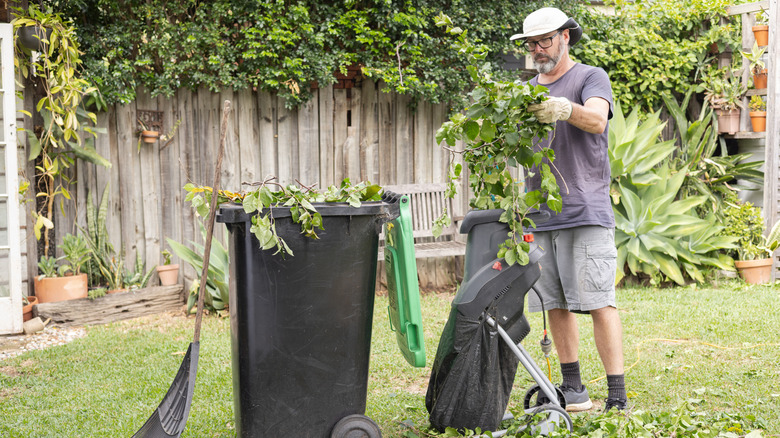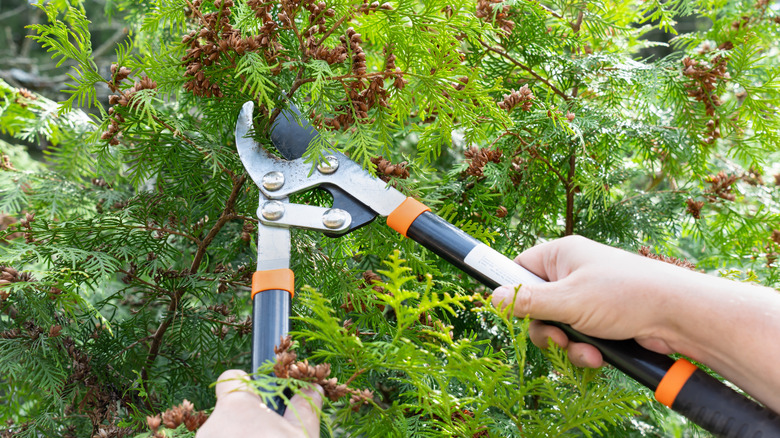Shearing Vs Pruning: How To Know Which Technique Your Shrubs Need
When you see one of your shrubs growing a little too wild, your first thought might be to grab those hedge shears and give it a trim. However, choosing what you think is the fastest or simplest approach isn't always the best option. Pruning with shears might not keep every overgrown shrub or tree at its healthiest. In fact, it could be one of the mistakes to avoid while pruning your plants. Whenever a shrub needs some attention, you should ask yourself one important question: Does this plant need pruning or shearing? Though the two techniques seem similar, they use different tools and have very different outcomes.
Pruning is all about making careful, selective cuts to improve the plant's structure and overall health. Shearing involves snipping away the outer layer of a shrub to sculpt the plant into a specific shape, like a rectangle or a ball. It's important to remember that the majority of flowering and deciduous shrubs benefit from selective pruning. Shearing is fast, and it certainly has its place in the garden, especially for those wanting to embody a formal aesthetic. Some hedge plant species are particularly well-suited to shearing. However, choosing the wrong method for your shrub can leave it sickly and struggling, even if it looks relatively healthy at a glance or for a while.
Selective pruning maintains shrub health and form
Pruning, also sometimes called selective pruning, is the best method for maintaining individual shrubs. The practice involves making precise, targeted cuts to branches using hand pruners, loppers, or a pruning saw. Pruning improves air circulation, allows sunlight to reach the inside of your shrub, promotes healthy growth, and removes dead, diseased, and damaged wood — also known as the three D rule for properly pruning your plants. Selective pruning encourages the shrub to direct energy throughout its system, strengthening it.
You should cut branches back to a lateral branch or a healthy bud to encourage the plant to grow in the direction you want. Knowing when to prune is also important, especially with flowering shrubs. For example, the popular lilac (Syringa vulgaris) flowers on old wood. Prune it at the wrong time of year and you'll cut off the next season's blooms. You need to wait until the flowering period is over in the spring before trimming the branches back. In other words, selective pruning keeps a shrub compact while ensuring optimal performance — whether that's abundant flowers, more fruit, or stunning fall foliage on a uniformly shaped plant.
Shear specific shrubs into formal shapes
Shearing differs from pruning in that it's done for purely aesthetic reasons. You can use this technique to carve shrubs into defined geometric shapes, like squares, cones, or spheres. Using manual shears or electric hedge trimmers, you clip back the soft, outermost layer of growth. When a plant is sheared, the cuts stimulate new growth only on the outside, which results in a shell of thickened foliage. The technique works well for formal hedges or topiaries, which need frequent trims throughout the growing season to maintain their form. Following maintenance tips to keep your garden shears in tip-top shape reduces damage to the plant.
Unfortunately, this thick outer layer prevents sunlight and air from reaching the inside of the plant. The shrub's branches can become weak, brittle, and bare. Constantly cutting off the tips of the new growth also removes the parts of the plant most responsible for photosynthesis. You essentially starve the interior of the shrub, making it more vulnerable to diseases and pests. For this reason, shearing is only recommended for certain types of tough, small-leafed plants. Boxwood (Buxus sempervirens), for example, is a hardy evergreen that grows well in Zones 5 to 8. If you're not creating a formal garden with these types of shrubs, stick to selective pruning to help your plants live longer, healthier lives.


